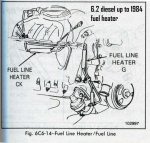Howdy: I know there are threads on the topic of spin on filters. I found a lot of info. I am thinking on using one on my truck. I am going to be relocating to Northern Idaho and was wondering about the heating element in the fuel filter block of the stock filter assembly. What kind of temperatures require the use of the heater? That will help with the decision on weather to replace the stock unit with another or to try to find a spin on with a heating element, or if one is needed at all. I hope I can get this mess of a truck straightened out before moving. One last question, What TM has wiring diagrams for power distribution and Glow Plug power? Thanks For all the you guys have given me. You have been life savers( and not the candy type)

Diesel fuel has two critical temperature points, those are pour point and cloud point. Pour point is the lowest temperature at which the fluid will flow. Cloud point is the temperature in which the wax begins to crystallize within the fluid. The difference between the two points is usually 20°F. Typical Diesel #2 has a cloud point of 40°F and a pour point of 15-20°F, however based on the actual cetane value of the fuel the low on the scale might be higher or lower.
Some engines will starve at the cloud point, these are typical those models without a fuel heater of some sort. I don't believe the CUCV came stock with a fuel heater. What begins to happen at this point is the crystalline wax begins to plug (gel up) the fuel filters. Give it long enough and it becomes plugged. Other vehicles have issues at the pour point this is because the fuel simple begins to stop flowing in the fuel lines. The OEM heater simple can't do it's job if fuel isn't making it to that point.
There are a number of ways to reduce the chance of fuel "gelling". Usually Oct-Apr, gas stations in the northern tier offer a Winter blend. This is typically Diesel #2 with a additive or a blend of Diesel #1 and #2. This can be problematic because their is no guideline or posted formula at which the fuel has been blended or what the new pour and cloud points are. Furthermore I believe some stations actually change the label and not the fuel. Subsequently making more money and providing little benefit.
Other options include running Diesel #1 or adding your own additive at fill up. I've found my F350 is very problematic and very picky when it comes to fuel. So I run both. Straight #1 and an additive, this is probably the most expensive alternative but this year I've ran down to -19°F without incident, a task not accomplished in years past. Yes this is probably an isolated incident, yes Ford has been notified about the issue however there is nothing that can be done about my truck aside from trading it in and losing a lot of $$$$. I've also found that my truck is not alone with this problem.
My issues aside, the last option which I have the parts for just have not done the install yet, is an aftermarket fuel heater. There are various manufactures that make them, the local diesel place in town installs an aftermarket version of the HFCM that is stock on my truck. This is basically a 12 volt heater within a filter housing, they also have a water/fuel separator. These aren't cheap but they aren't very expensive either. As my current HFCM is operational I didn't feel that adding basically a second was a solution...
I decided after a lot of research an inline coolant heated fuel heater or significant size was what I needed. I went to a company called Arctic Fox, out of Delano Mn. The have a huge catalog of fuel heaters. I originally wanted a in tank heater however non of there models will work in the OEM plastic fuel tank in my F350. The models they offer are designed to bolt to a flat or curved steel fuel tank like one would find on nearly ever over the road truck and heavy equipment. The also offer heated fuel line, very $$$$ and I think the smallest line they offer is 1" inside diameter not exactly low flow.
The model I purchased is designed to heat B100. The model has 4 ports 2 for fuel at either end and two for coolant again at either end. The design allows fuel to flow in one direction while coolant from the engine runs the other. Inside of the chamber the fuel flows through the 7 inner pipes while the coolant flows through a water jacket surrounding the smaller diameter fuel pipes. My model also has a 120 volt preheat option so that you have heat ability while the engine coolant heats up to 180°F. In a return fuel system like found in my F350 supposedly the heater will allow the heated fuel to circulate and heat the tank. I'm not sure if that's actually possible or if it is how long it would take.
The best option is probably just to use an additive in winter and when the temps are supposed to get below 0°F fill up with #1. For a point of record I use Stanadyne additives.
Any questions don't hesitate.








